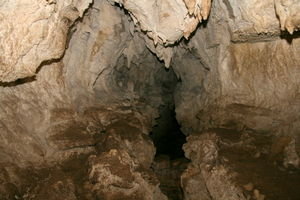Advertisement
Published: September 22nd 2007

 Fox River Caves
Fox River Caves
Inside the Fox River cavesAnother fine day could not be passed up. I headed out to the coast to the Fox River about 20 minutes south of Westport and hiked about 8 kms inland alongside the river to a cave set into the wall of a limestone gorge. It was a spectacular, sunny day. The walk follows the banks of the river crossing it in two places before heading up the gorge along a path of slippery of rocks. The entrance to the cave is striking in its own right. I saw one young couple on the way to the caves, but there was otherwise no sign of anyone. This made the cave exploration all the more isolating. Exploring the cave alone and unguided was at times an eerie experience, with the constant sound of dripping water. An unanticipated sighting of a cave weta (a cross between a cockroach and a grasshopper) caused a bit of over-reaction.
The cave itself runs a respectable 200 metres deep. While there are a few narrow sections, the length of the cave is fairly accessible. I had a tramping head lamp and a sizeable Maglite which was absolutely necessary as the light penetrates no more than a few feet into the cave. The cave has been carved out of the rock over thousands of years by acidic surface water enriched with carbon dioxide from plant roots and decaying forest-floor litter seeping through the cracks and fissures in the limestone. Calcite in the water precipitates out creating the picturesque stalactites and stalagmites.
On the way back to the truck, I came a cross of group of people camped at the side of the river. This is white-bait season and all across the west coast whitebaiters are throwing their nets in hopes of pulling these very expensive juvenile fish out of the water. The most common whitebait species in New Zealand is the inanga, which lays its eggs during spring tides in Autumn on the banks of a river amongst grasses that are flooded by the tide. The next spring tide causes the eggs to hatch into larvae which are then flushed down to the sea with the outgoing tide where they form part of the ocean's plankton mass. After six months the developed juveniles return to rivers and move upstream to live in freshwater. The current rate for whitebait is $110-130 per kilogram.
Advertisement
Tot: 0.083s; Tpl: 0.012s; cc: 11; qc: 32; dbt: 0.0531s; 1; m:domysql w:travelblog (10.17.0.13); sld: 1;
; mem: 1mb

 Fox River Caves
Fox River Caves